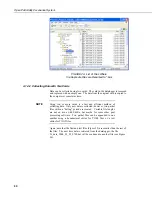
Appendix A. Sensor Orientation
A-2
Declination angles are always subtracted from the compass reading to find
True North. A declination angle East of True North is reported as positive a
value and is subtracted from 360 (0) degrees to find True North as shown
Figure A-2. A declination angle West of True North is reported as a negative
value and is also subtracted from 0 (360) degrees to find True North as shown
in Figure A-3. Note that when a negative number is subtracted from a positive
number, the resulting arithmetic operation is addition.
For example, the declination for Longmont, CO (10 June 2006) is 9.67
°
, thus
True North is 360
°
- 9.67
°
, or 350.33
°
as read on a compass. Likewise, the
declination for Mc Henry, IL (10 June 2006) is -2.68
°
, and True North is
0
°
- (-2.68
°
), or 2.68
°
as read on a compass.
FIGURE A-2. A Declination Angle East of True North (Positive) is
Subtracted from 360 (0) degrees to Find True North
FIGURE A-3. A Declination Angle West of True North (Negative) is
Subtracted from 0 (360) degrees to Find True North



























